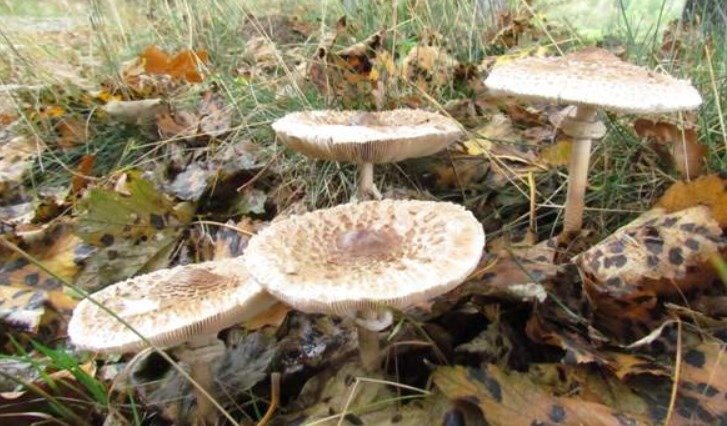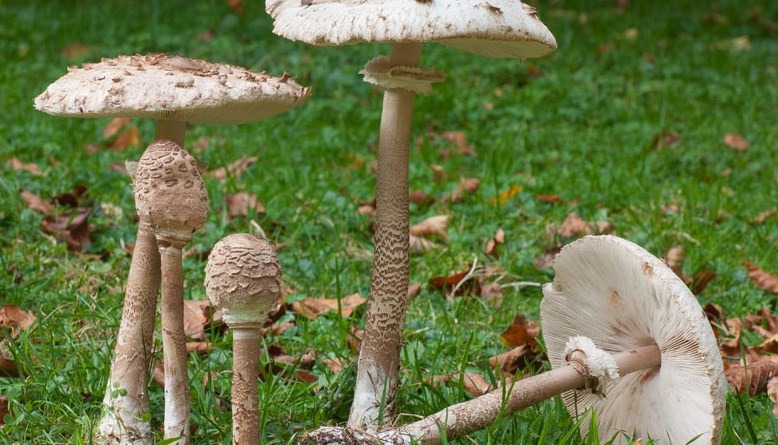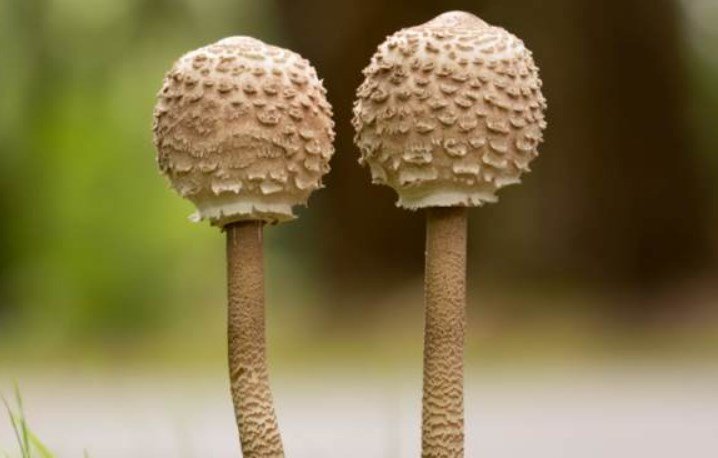Macrolepiota procera is the classic Parasol Mushroom, a very recognizable mushroom is sought after because edible mushroom of good quality. Really easy to recognize and above all to find, seen that it is a large mushroom spread almost everywhere, the parasol mushroom has the characteristic tiger stem with double ring and, above all, the shape of an “umbrella”.


Other names of Parasol Mushroom
Macrolepiota procera is known by many other names: as already said the most classic parasol mushroom. Other synonyms are lepiota procera, leucocoprinus procerus, agaricus procerus. Other common but commonly used names are in Italy are Bubbola Maggiore, fungo parasole (parasol mushroom), fungo coppolino, fungo tamburo (drum mushroom), cappellaccio, and finally fungo ombrello (umbrella mushroom).
The name drum mushroom refers to the fact that the shape of the young specimens of the fungus, when the cap is still closed in the shape of a sphere and the stem is fine and completely stretched, may recall the drumsticks of the drummers. The origin of the name parasol, on the contrary, is quite easy to imagine, then, that it really resembles an umbrella talking about the sunlight.
Description of the Macrolepiota procera
The parasol mushroom is a mushroom safe enough to collect and easy to determine. It should be distinguished from the related species Lepiota rhacodes which is characterized by woolly scales above the cap and a shorter stem (and also the flesh that stains red).
Stipe
The stipe of the Macrolepiota procera must always be discarded because it is too woody and is always indigestible. Therefore, only the hat is used.
This mushroom has a cap which measures from 15 to 30 cm of diameter; it can be found also of bigger dimensions and up to 40 cm.
At the beginning of its growth the cap is shaped like a bell, then it widens more and more around a central umbo that lowers more and more and sometimes disappears completely.
The surface of the cap of the macrolepiota procera is first light brown and then breaks into several large scales that rise slightly and allow a glimpse of the lower surface of the cap that is lighter than the upper one.
The colour of the cap is yellowish white or hazelnut with darker scales. The colour of the cap can vary from grey to light hazelnut and also the scales can be more or less thick. The ring is always White in the upper part and brown in the lower one.
Gills
The gills of the Macrolepiota procera are very thick and very wide. They are also thin and free from the stipe. The colour is white, tending to pink or yellow with the ripening of the fungus.
Stipe
The stipe of the parasol mushroom measures from 15 to 30 cm high and one and a half centimetres (up to 2 maximum 3 cm) thick. At the beginning of the growth of the mushroom, the stalk is stocky and very short, conical in shape, and then it stretches and gets slimmer, becoming thinner. At the bottom, it remains enlarged and ends with a bulb.
Also the surface of the stipe of the drum club as well as the surface of the cap melts with the passing of time and the scales let glimpse the lighter part underneath. These scales are arranged in concentric and wavy rows and make the whole stem appear streaked between light and dark colours.
The stipe is hollow inside is very thin and slender. Since it has to bear the weight of the hat is very fibrous and woody and this determines its strength. This characteristic, however, makes its own stipe not edible.
Ring
The ring is membranous, large and with a torn edge. The colour is white above and below, darker, towards brown. The ring is sliding on the stipe.
Flesh
The flesh is very soft in the cap and too stoppy in the stipe. The colour is creamy white and does not change with the cut. The smell and taste are good. The texture is tender except in the stalk where, as mentioned, it is fibrous.

Habitat and Diffusion
The drum parasol mushroom is very common in our regions and being saprophyte mushroom can grow in the most diverse environments. It is found in pastures, vineyards, orchards, fields cultivated after harvesting, in deciduous forests and also in those of conifers.
Macrolepiota procera can develop at any altitude and in any type of terrain even beyond 2000 meters. It is often found on the edge of sparse forests or in clearings. It can be found either alone on the ground or in small groups.

Growth period
Macrolepiota procera grows commonly in summer and also in autumn, especially after heavy rains. It takes 4 to 10 12 days for the drumstick to grow.
At the beginning, only the truncated cone shaped cap appears from the ground. Then the cap takes the form of an oval, like a bullet, and the stem rises more and more until it reaches its maximum height. At this point the hat expands and first takes the shape of a spherical globe and then the classic appearance of a sun umbrella.
Mushrooms similar to Macrolepiota procera
The Macrolepiota procera can be confused with the Amanita pantherina which is poisonous and differs because it has a minute ring that does not flow and the cap full of small white warts. Also among the lepiota mushrooms there are some poisonous species and they are all small sized mushrooms with scaly cap. Another similar species is the Macrolepiota rhacodes.
Recipes with parasol mushroom
We have already said that the stipe of the parasol mushroom is inedible because it is too hard. The cap, on the other hand, depending on the stage of development, can be cooked in various ways.
- If the cap is small or still closed you can fry it; it looks like a small egg and it is very good.
- If the cap is open, it can be stuffed and stewed.
- When it is completely open, you can bread and fry it like a cutlet.
The third way is one of the most classic ways of cooking the Macrolepiota procera. You can cook the large open caps by burning them on the grill or cook them with butter like breaded steaks.
The parasol Mushroom is not a mushroom that needs special cleaning as it is often free from insects, apart the overripe specimens.
When cleaning, just brush off the soil and possibly avoid washing them because they absorb water that attenuates the taste. Some people eliminate scales because they are annoying to the palate. The parasol Mushroom can also be sautéed over low heat with a little oil, garlic and parsley in a pan.
They are not very suitable for storing under pots and pans. Much better to eat fresh mushrooms that you find and that for their size can not really escape the eyes of collectors.
Parasol mushroom Salad
Let’s get half a kilogram of Macrolepiota procera, a glass of oil, lemon juice, salt, pepper and a little parmesan cheese. Let’s look for mushrooms that are still closed like an egg, clean them from scales and affect them subtly.
We put them in a bowl and mix them together with the oil, the juice of half a lemon and a little salt and pepper. With this sauce we sprinkle the mushrooms and let them soak for a few tens of minutes. We serve them sprinkled with parmesan cheese directly at the table.
Macrolepiota procera with olive oil
We always choose the young and tender specimens and clean themselves. Put them in a pot of boiling water with a little vinegar and let them boil for about ten minutes and drain.
Arrange them on a cloth to dry, then cut into slices and simply season with olive oil and a little ‘salt and pepper. This is a preparation reminiscent of the Mushroom Amanita caesarea.
Cutlet with Macrolepiota procera
We are looking for 4 – 8 hats of drum mace mushrooms, two eggs, 50 grams of butter, salt, pepper and a little lemon. We clean the caps of the mushrooms always leaving them whole or at most cutting them in half (or in four if they are too big).
Pass through the beaten eggs and breadcrumbs, then place in a pan with the butter and the mushrooms with salt and pepper on top. Let them fry for about ten minutes turning them often and serve the dish garnishing it with some slices of lemon.
Baked Macrolepiota procera
For this recipe you need 4 to 8 hats of parasol mushroom, half an onion, parsley, breadcrumbs, oil, butter, salt and pepper.
Clean the mushroom caps well and place them upside down on a buttered baking sheet. Chop half an onion finely and the parsley and mix with a little breadcrumbs, oil, salt and pepper.
Now mix well and distribute this filling in the cavity of each cap The dish is completed with a little butter and baked for 20 minutes with moderate heat.
Macrolepiota procera with garlic in the grill
You always need 4 or 8 mushroom hats. Let’s also get a clove of garlic, parsley and half a glass of olive oil. After cleaning the mushroom hats, they are joined on the outside surface and placed on the grill with the gills facing upwards.
Trim the garlic with the parsley and place this straight on top of each cap with a little salt and pepper. Drizzle with oil and let it roast for 10 minutes, often soaking with the cooking liquid.
Macrolepiota procera in Onion Roast
We wash well the hat of 4-8 parasol Mushroom always if possible young and tender. We turn them with the outer surface upwards and put them on the grid. Chop the onion and parsley and mix in some breadcrumbs, oil, salt and pepper.
Mix everything together and distribute the filling in the cavities of the cap. Once this is done, cook for a quarter of an hour over low heat, sprinkling with a drizzle of oil.
IDENTITY CARD
CAT COLOR: Bruno
STIPE HEIGHT: 10-40 cm
COLOR: brown
GILLS: white
FLESH: White
SMELL: Hazelnut
TASTE: hazelnut
SPORES: creamy white
HABITAT: Fields and Meadows
Did you find what you were looking for? See also here:
- Ganoderma Lucidum
- Armillaria Mellea
- Amanita Caesarea
- Agaricus Bisporus
- Amanita Phalloides
- Coriolus Versicolor
- Flammulin Velutipes
- Marasmius Oreades
- Pleurotus Ostreatus
- Agaricus Campestris
- Macrolepiota procera